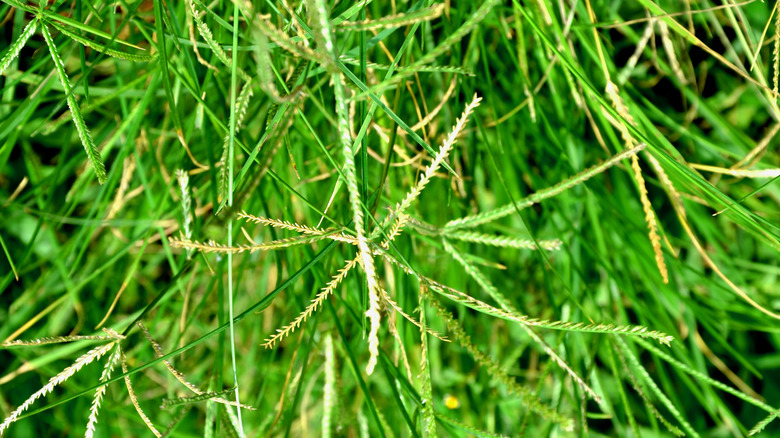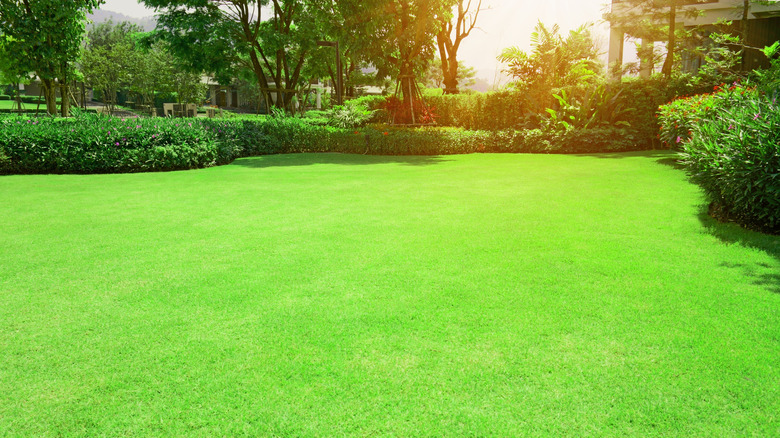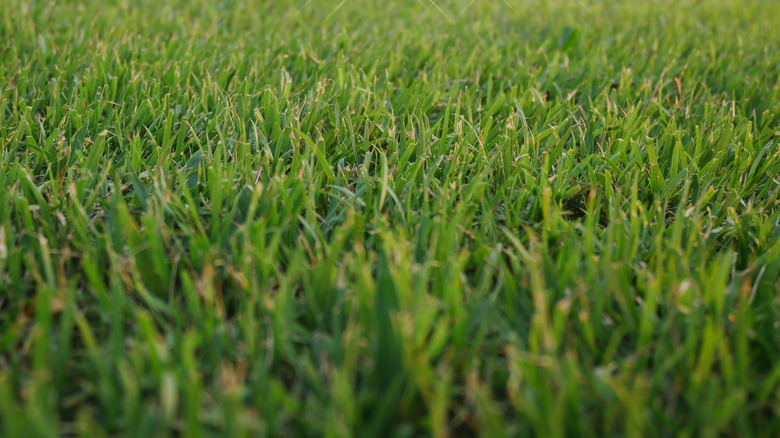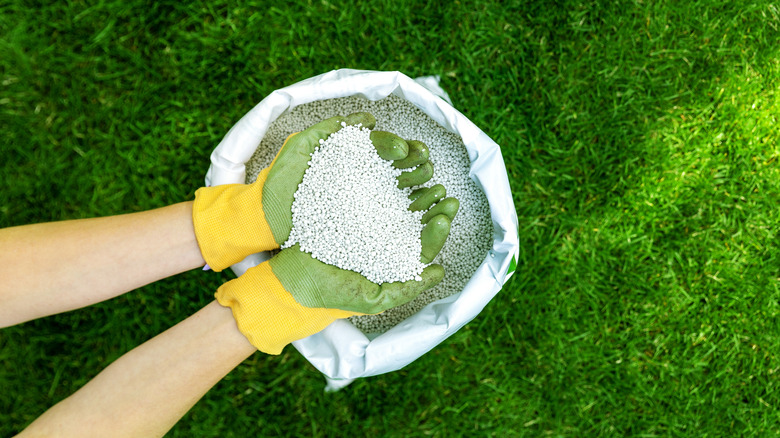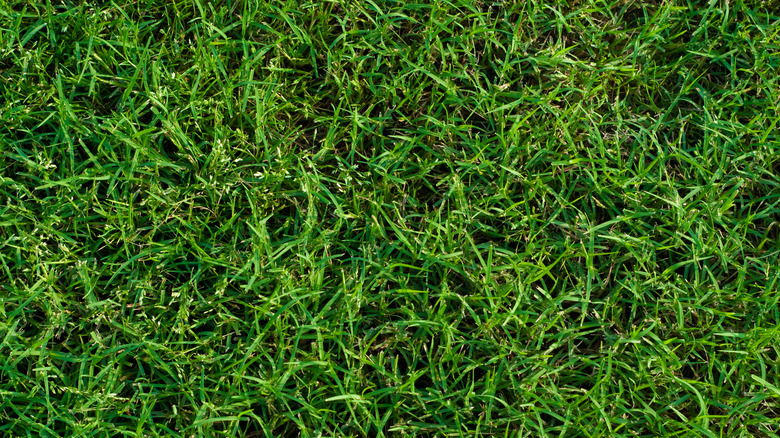The Best Way To Care And Grow Bermuda Grass
Bermuda grass (Cynodon dactylon) is a warm-weather variety known for its ability to tolerate heat and drought. It is mostly used in the southern and southwest parts of the United States, and when in its vegetative state, it is identified by its dark green color and V-shaped leaf blades with a deep notch at the tip. This unique blade shape makes it easy to differentiate from other common warm-season grasses: It can be used to create a dense, soft ground cover and can handle plenty of foot traffic without incurring damage. Bermuda grass is available in seed or sod form and makes an ideal turf for yards in the appropriate climate zones.
Bermuda grass is native to the world's tropical regions. It is hardy in U.S. Department of Agriculture plant hardiness zones 7 through 10, where it prospers in warm weather and soil conditions ranging from sandy to clay. According to Pennington, Bermuda grass thrives in the warm-season zone of the United States but can also survive in the transition zone, depending on the variety. With proper care, Bermuda grass can form a dense sod that thrives in full sun but can also grow in the shade. Bermuda Grass is a warm-season grass, which means it grows during the summer months and goes dormant in colder weather. Let's explore whether Bermuda grass is right for your lawn and explain how to care for it so it remains lush and green for as long as possible.
Why Bermuda grass is great for lawns
According to the Arizona Cooperative Extension, Bermuda grass was first used for lawns in the United States in the early 1900s for athletic fields and golf courses because of its durability and ease of establishment. Bermuda grass is one of the more versatile types of turfgrass available. It has become a popular choice for home lawns, golf courses, and athletic fields across the United States because of its aggressive growth habit and its ability to tolerate high temperatures, drought conditions, and heavy foot traffic. In addition, because it can handle low quantities of water, it's an exceptional choice for lawns in areas where water is scarce or expensive.
Although Bermuda grass is primarily a warm-season turfgrass, it can tolerate cold temperatures as long as there is sufficient moisture in the soil. Once temperatures start to consistently fall below freezing, however, the grass will turn brown until the weather warms up again. The shorter the cold weather period is, the more likely your Bermuda grass will thrive. In addition, it can be over-seeded with cool-season grasses such as ryegrass during the winter months in areas where winters are mild so that the lawn stays green all year long.
How to care for Bermuda grass
Water Bermuda grass deeply but infrequently to encourage deep rooting. According to Pennington, Bermuda grass should receive at least 1 inch of water each week from rainfall or irrigation; however, don't let the soil become waterlogged. Water more frequently if the lawn receives heavy foot traffic. Use a hose-end sprinkler to apply water to the lawn to ensure that it receives even coverage over the entire surface area. The best time to water Bermuda grass is in the morning between 6 a.m. and 8 a.m., as this will reduce the loss of water due to evaporation and absorbed heat. In addition, watering during this time reduces the risk of fungal diseases developing on your lawn because the sun will dry out any moisture that remains on the leaves after watering.
The amount of sunlight needed for it to thrive varies depending on the type of Bermuda grass you choose for your yard or garden area. Common Bermuda grass should receive at least six hours of sunlight daily for optimal growth. Furthermore, ensure you mow it regularly to maintain the desired height. Bermuda grass needs mowing once every five to seven days during the growing season and should be kept at a height of between 1 and 1.5 inches. Mow frequently enough so that only one-third of the leaf is being cut while mowing.
Fertilizing Bermuda grass
As the weather warms in spring, Bermuda grass comes out of dormancy and begins to grow. Although it is a hardy, drought-tolerant grass, it needs regular maintenance and care if you want it to look its best. Before seeding your lawn, test your soil's pH level using a home testing kit. According to the Clemson Cooperative Extension, Bermuda grass prefers soil with a pH of 6 to 6.5, so adjust the pH level as needed by adding lime or sulfur to the ground before planting. Fertilizing the grass in the spring helps to ensure that it will thrive during the summer months when it gets most of its growth.
To help it grow beautifully, purchase a high-quality fertilizer labeled specifically for Bermuda grass from your local hardware store or garden center. Choose one with an NPK ratio of 4:1:2, such as 16-4-8, which means it has 16% nitrogen, 4% phosphorus, and 8% potassium: These three elements are the primary nutrients required for healthy plant growth. Nitrogen aids in leaf growth and gives lawns their green color. Phosphorus encourages root growth, which is important for newly germinated seeds, while potassium promotes strong stems and disease resistance. Apply the fertilizer when the grass starts to grow in the spring but before it grows higher than 3/4 inch tall and spread it at a rate of 1 pound per 1,000 square feet of lawn with a handheld spreader.
Bermuda grass varieties
There are many different Bermuda grass varieties, so make sure you do your research before purchasing seeds. Certain types will work well for you depending on where you live and what you intend to use them for. Let's take a closer look at each one so you can decide which is best for your lawn.
- Common Bermuda grass: This turf-type is the most prevalent type of Bermuda grass. It grows in various soil types, has a dark green color, and thrives in warm weather but grows best in full sun. Common Bermuda grass is drought tolerant, but it will turn brown or go dormant during the winter months.
- Celebration Bermuda grass: This variety has finer blades and unique blue-green color, according to Sod Solutions. It's more shade-tolerant than common Bermuda grass, making it ideal for lawns that don't receive full sunlight.
- Latitude 36 Bermuda grass: This is an excellent cold-weather type that can grow further north in the country than many other types of Bermuda grass. It has a vibrant color and a fine texture, making it comfortable to walk on.
- Tifway 419 Bermuda grass: This variety is ideal for sports fields and areas that get a lot of foot traffic. It has a deep green color and was bred to be particularly resistant to weeds and diseases.
